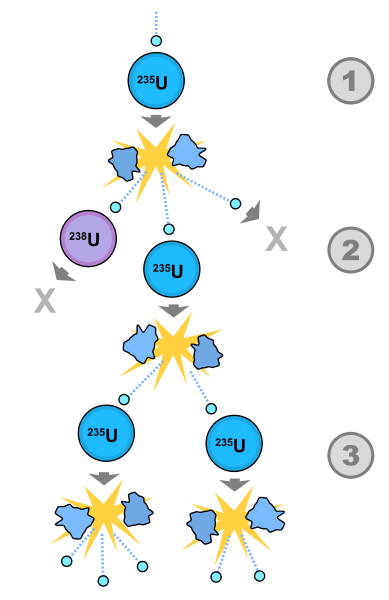Students learn the basics of nuclear fission and explore its uses from the Manhattan Project onward. They are then asked to take sides on whether or not this technology has been a positive or negative development. Submitted by Jeff Gorum.
Procedure:
Day 1
As students enter the room, they respond to three questions in a journal:
- What is nuclear fission?
- How does nuclear fission benefit you today?
- How does nuclear fission benefit others today?
Discussion and response:
The teacher uses the three questions above to introduce the concept of nuclear fission and uses of fission which have developed since the dawn of the atomic age. A general overview of the Manhattan Project, specifically the work done at Los Alamos, NM is given. Students are encouraged to relate any personal stories they have regarding the project.
As part of the discussion phase, students are made aware that a debate arose during the Manhattan Project over whether the use of forces made available by nuclear fission was appropriate from a moral standpoint. Specifically, students will be made aware that a petition was circulated asking that the initial bombs be dropped on non-populated areas, but this petition never made it past General Groves.
Students will be given the names of several of the key players in the Los Alamos leg of the Manhattan Project, and the class will go to the library where both print and Internet sources are available for research. Students will research at least three key players, taking notes on 3X5 cards on each, which will be submitted at the end of the day as evidence of the days work. The next day, students will have their cards returned to them, and they will form two groups, one in favor of using nuclear force, one opposed. Students in each group will choose a key player to represent, and a debate will be held, moderated by the teacher, using their players points of view for arguments. Day 1 will end in the library.
Day 2
Note cards are returned to students. Students take a few moments to review their notes, while the teacher makes assignments to one of two groups. The room is separated into two groups of desks, one for the “in favor” group, one for the “opposed” group. The two groups take a few minutes to talk and decide on 6 key points for argument, and choose a primary spokesperson.
The debate then begins. Students debate the issue for approximately 20 minutes, at which time the teacher thanks the presenters, and summarizes the debate and issues for the students. The final assignment of the day is for each student to write a one-paragraph summary of their learning and their own personal feelings on the nuclear debate. Follow-up for the debate will consist of a discussion of how the science developed during the Manhattan Project has benefitted people of today.





